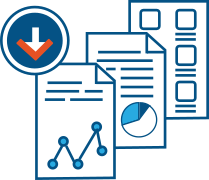Robotic Process Automation (RPA) is a technology that uses software “robots” or digital agents to automate repetitive, rules-based administrative tasks traditionally performed by humans. These software bots mimic human interactions with digital systems—such as logging into applications, entering data, extracting files, processing transactions, or validating forms—at high speed and with minimal error.
In the context of government procurement, GSA Schedule management, and federal operations, RPA is increasingly being adopted to streamline complex administrative processes, reduce manual effort, and improve accuracy in data-heavy workflows.
Key Characteristics of RPA
RPA tools are designed to:
- Follow structured workflows based on clear logic and decision rules
- Interact with software systems via the user interface, simulating mouse clicks, keyboard inputs, and navigation
- Operate 24/7 without fatigue, increasing throughput and responsiveness
- Integrate across legacy and modern platforms, making them highly adaptable
- Leave audit trails, supporting transparency and compliance requirements
Unlike artificial intelligence (AI), which adapts through learning and inference, RPA operates within a static logic framework—making it ideal for predictable, process-driven environments such as federal acquisition.
Common Use Cases in Government and GSA Environments
RPA has proven particularly useful in automating tasks across a wide range of acquisition and contract administration functions, including:
1. GSA Contract Processing
- Automating routine data entry during offer and modification submissions
- Populating contract clauses and administrative templates
- Transferring contract data between systems (e.g., from eOffer to internal databases)
2. Sales and Reporting
- Extracting and validating contractor sales data from uploaded reports
- Pre-calculating IFF (Industrial Funding Fee) obligations
- Flagging anomalies or missing records during quarterly review cycles
3. Compliance Monitoring
- Checking contractors’ active status in SAM.gov
- Verifying up-to-date Reps & Certs filings
- Scraping catalog listings to ensure pricing and TAA compliance
4. Invoice and Payment Reconciliation
- Matching invoices to contracts and task orders
- Validating billing against awarded rates and quantities
- Sending alerts or automated follow-ups for discrepancies
5. Customer Service and Workflow Routing
- Auto-responding to repetitive inquiries with status updates
- Routing requests to the appropriate point of contact
- Generating notifications for pending deadlines or tasks
These functions free up acquisition professionals and contractors to focus on more strategic, high-value tasks while improving the speed and consistency of administrative activities.
Benefits of RPA in Federal Acquisition
Implementing RPA in the GSA and broader federal procurement space brings several key advantages:
- Increased efficiency: Tasks that took hours can be completed in minutes
- Improved accuracy: Reduces human error in data entry and validation
- Cost savings: Less reliance on manual labor for repetitive administrative work
- Scalability: Can handle spikes in workload (e.g., fiscal year-end processing) without additional headcount
- Compliance support: Provides detailed logs and reproducible steps for audit readiness
- Interoperability: Works across legacy systems, databases, and document repositories
For GSA contractors, RPA improves turnaround time for catalog uploads, modification approvals, and compliance tracking—resulting in better customer service and fewer operational delays.
RPA vs. Other Automation Tools
While RPA is a powerful technology, it is often part of a broader automation toolkit that includes:
- Business Process Automation (BPA) – Automates broader workflows and decision-making processes
- Application Programming Interfaces (APIs) – Allow direct system-to-system data exchanges (more structured, but less flexible)
- Artificial Intelligence (AI) – Adds learning and adaptability to handle unstructured data and complex logic
RPA stands out because it does not require deep system integration and can be deployed quickly to address legacy workflows or bottlenecks without overhauling backend infrastructure.
RPA in GSA Strategic Initiatives
GSA has been a federal leader in RPA adoption, using the technology in initiatives such as:
- The Robotic Process Automation Program Office, which supports agency-wide RPA governance
- AI and Automation Centers of Excellence, promoting shared use cases across agencies
- RPA deployments in the Federal Acquisition Service (FAS) to process contract modifications and compliance checks
- Use in platforms like CODY and other procurement automation tools to handle high-volume administrative actions
These programs are part of GSA’s larger push toward digital modernization, data-driven decision-making, and improved service delivery across government.
Best Practices for Contractors Using RPA
While RPA is primarily adopted by agencies, large GSA contractors may also use RPA internally to manage compliance and contract operations. Best practices include:
- Start with highly repetitive, rule-based tasks that drain manual effort
- Map out your existing processes before automation to ensure consistency
- Ensure outputs are traceable and auditable, especially for GSA compliance tasks
- Avoid automating broken processes—clean up and standardize first
- Work with your IT/security teams to ensure bots meet federal cybersecurity requirements
Examples include automating SIP uploads, IFF calculations, and SAM status checks.
Conclusion
Robotic Process Automation (RPA) is reshaping how both agencies and contractors manage repetitive, rules-based processes in the federal acquisition space. By leveraging software robots, organizations can improve operational efficiency, reduce error rates, and accelerate turnaround times for critical tasks like compliance checks, catalog updates, and data processing. As GSA and other federal entities continue to modernize their procurement infrastructure, RPA will remain a foundational tool in delivering faster, smarter, and more accountable public services.


